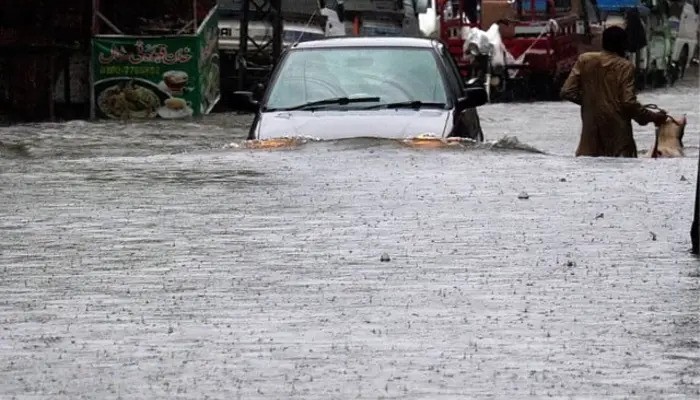
Flash floods have intensified across Pakistan, pushing the national death toll to 252 as relentless monsoon rains continue to batter the country. The National Disaster Management Authority (NDMA) confirmed that 10 more people died in the past 24 hours alone. The widespread destruction has overwhelmed multiple provinces, heightening concerns about infrastructure, safety, and emergency preparedness.
Deadly Toll Grows Across Regions
According to NDMA, the latest fatalities include four in Punjab, four in Khyber Pakhtunkhwa (K-P), and two in Gilgit-Baltistan (G-B). No new deaths were reported from Sindh, Balochistan, or Azad Kashmir. Punjab remains the hardest-hit province with 139 reported deaths. K-P follows with 60 casualties, while Sindh and Balochistan reported 24 and 16 deaths, respectively.
The agency revealed that the deceased include 121 children, 46 women, and 85 men. Since the monsoon season began in late June, almost every region has suffered, either from deadly downpours or the flooding that followed.
Children Among Victims in Islamabad
In Islamabad, six people, including four children, were swept away by flash floods. Gilgit-Baltistan reported five more deaths, and Azad Kashmir added two to the toll. Authorities are warning that the toll may rise further as conditions worsen and new weather systems approach.
Tarbela Dam on High Alert
In a worrying development, the Tarbela Dam has issued a high alert. The dam’s water level has surged to 1,530 feet, just 20 feet below capacity. Inflow currently stands at 333,000 cusecs, nearly equal to the outflow. Despite the flood pressure, all 17 power units remain operational, generating 3,500 megawatts of electricity.
Tourist Areas Brace for Impact
In K-P, where tourism is a major industry, emergency response units have been deployed under the direction of Tourism Advisor Zahid Chanzeb. These units are active in Peshawar, Hazara, and Malakand divisions. All staff leave has been cancelled, while tourist police and helpline 1422 have been mobilized to assist stranded or vulnerable individuals.
Read: Monsoon Returns: Karachi Gets Light Rain, More Rain Ahead
More Rain Forecasted Until July 25
Weather experts have warned that rainfall is expected to persist until July 25. Citizens are being urged to avoid flood-prone zones, especially low-lying urban areas and riverbanks.
Flash Flood Warning in Northern Pakistan
The Pakistan Meteorological Department (PMD) has issued alerts for July 23 and 24. Heavy rains are expected to cause flash flooding in local streams and nullahs across several districts. These include Chitral, Swat, Shangla, Mansehra, Abbottabad, Murree, Rawalpindi, and parts of northeast Punjab and Kashmir.
Meteorological Forces Behind the Crisis
A seasonal low-pressure system over northwest Balochistan, combined with moist winds from the Arabian Sea and a westerly wave over northern regions, is fueling these extreme conditions. The Met Office warns of further flash floods, landslides, and urban waterlogging in the coming days.
Urban Flood Risk Across Cities
Major cities such as Lahore, Faisalabad, Gujranwala, Rawalpindi, and Peshawar are facing severe urban flooding threats. Drainage systems are under heavy stress due to constant downpours and rising moisture levels. City authorities have begun monitoring vulnerable neighborhoods, deploying pumps and clearing clogged sewers where possible.
Landslide Alerts in Mountainous Areas
In mountainous zones like Murree, Galliyat, Gilgit-Baltistan, and Kashmir, the risk of landslides and mudslides is high. Transport departments have advised against unnecessary travel, citing threats of road closures and potential isolation due to debris or rockfalls.
Rainfall Data Highlights Widespread Impact
Rainfall data reveals heavy precipitation across affected regions. Muzaffarabad in Kashmir received 49 mm of rain, while Kotli saw 16 mm. Kakul in K-P registered 31 mm, and Balakot received 26 mm. Bagrote in G-B recorded 9 mm, highlighting how even relatively light showers can trigger flash floods in vulnerable terrain.
Nation Faces Days of Uncertainty
As rain continues to lash the country, millions remain at risk. The government has ramped up emergency response measures, but with saturated soil and rising water levels, the margin for disaster is slim. The next few days will be critical in determining how well Pakistan withstands one of its most destructive monsoon spells in years.
Follow us on Instagram, YouTube, Facebook,, X and TikTok for latest updates
